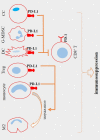Checkpoint inhibitor/interleukin-based combination therapy of cancer
- PMID: 35301813
- PMCID: PMC9359865
- DOI: 10.1002/cam4.4659
Checkpoint inhibitor/interleukin-based combination therapy of cancer
Abstract
Background: Immunotherapy using immune checkpoint inhibitors (ICIs) is the current focus in cancer immunotherapy. However, issues are raised in the area, as the recent studies showed that such therapeutic modality suffers from low durability and low or no efficacy for patients with some tumor types including cases with non-inflamed or cold cancers. Therefore, efforts have been made to solve the issue using immune combination therapy, such as the use of immunocytokines. The combination of ICI with interleukins (ILs) and IL-targeting agents is now under consideration in the area of therapy, and the primary results are promising.
Purpose: The focus of this review is to discuss the possibility of using ILs and IL-targeting drugs in combination with ICI in cancer immunotherapy and describing recent advances in the field using PEGylated ILs and fusion proteins. The key focus in this area is to reduce adverse events and to increase the efficacy and durability of such combination therapy.
Keywords: combination therapy; immune checkpoint inhibitor; interleukin; programmed death-1 receptor; programmed death-ligand 1.
© 2022 The Authors. Cancer Medicine published by John Wiley & Sons Ltd.
Conflict of interest statement
The authors declare that they have no conflict of interest.
Figures



References
-
- Mortezaee K, Goradel NH, Amini P, et al. NADPH oxidase as a target for modulation of radiation response; implications to carcinogenesis and radiotherapy. Curr Mol Pharmacol. 2019;12(1):50‐60. - PubMed
-
- Seo H, Kim B‐S, Bae E‐A, et al. IL21 therapy combined with PD‐1 and Tim‐3 blockade provides enhanced NK cell antitumor activity against MHC class I–deficient tumors. Cancer Immunol Res. 2018;6(6):685‐695. - PubMed
-
- Goradel NH, Mohajel N, Malekshahi ZV, et al. Oncolytic adenovirus: a tool for cancer therapy in combination with other therapeutic approaches. J Cell Physiol. 2019;234(6):8636‐8646. - PubMed
Publication types
MeSH terms
Substances
LinkOut - more resources
Full Text Sources
Medical
Research Materials

